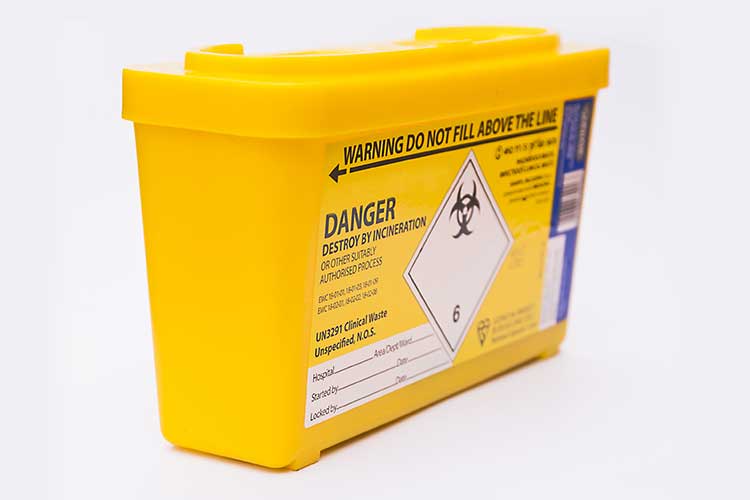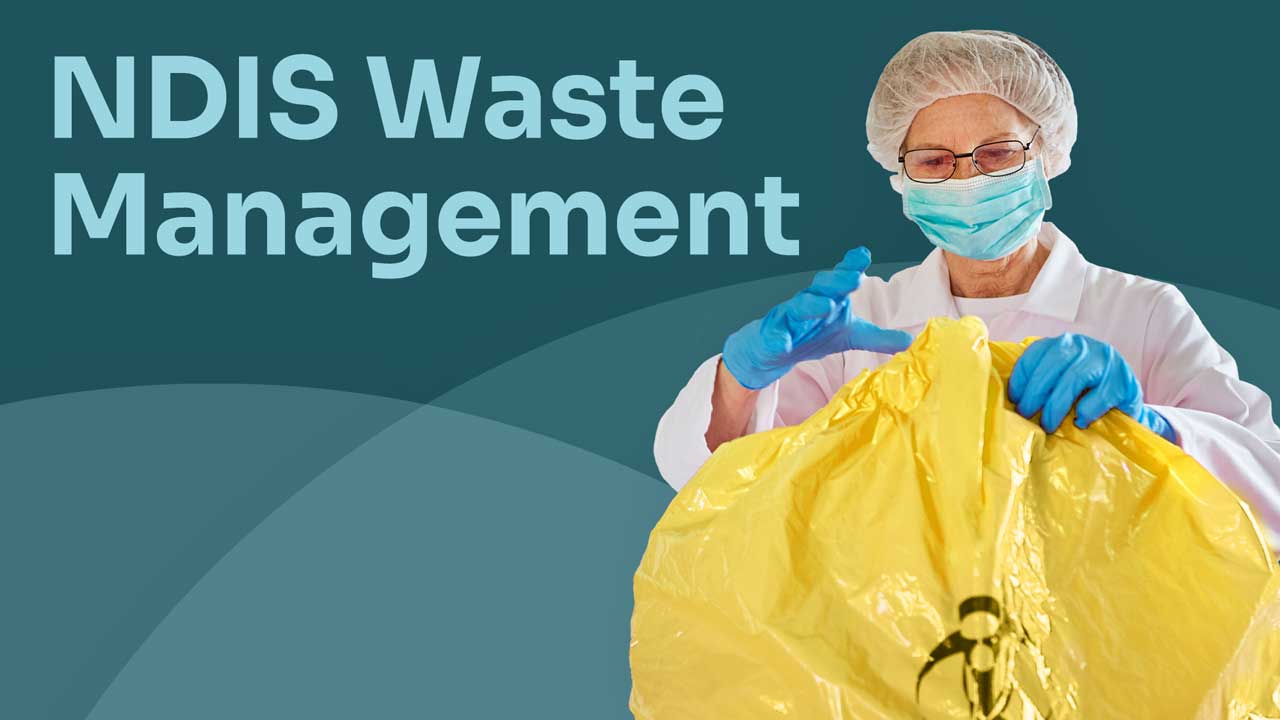Did you know that 15% of healthcare waste is classified as hazardous (WHO 2018)?
In order to minimise the risk of harm from hazardous healthcare waste, it’s crucial to have policies and procedures in place to ensure waste is handled, stored, packaged, labelled and transported correctly (Queensland Government 2024).
What is Hazardous Waste?
The term healthcare waste describes any waste generated through clinical activity, with the majority (about 85%) considered ‘general’ (non-hazardous). Healthcare waste that poses a risk of injury, infection or harm to human health is classified as hazardous (WHO 2018).
Hazardous waste includes:
- Infectious waste
- Waste contaminated by body fluids
- Laboratory waste (e.g. cultures and stocks)
- Waste from participants who have infections (e.g. bandages, swabs)
- Pathological waste
- Human tissue, organs or fluids (not including hair, teeth and nails)
- Contaminated animal carcasses
- Sharps (needles, syringes, disposable scalpels and blades)
- Chemical waste (e.g. disinfectants, batteries, heavy metals in medical devices)
- Pharmaceutical waste (expired, unused or contaminated medicines and vaccines)
- Cytotoxic waste that contains genotoxic agents (e.g. cancer medications)
- Radioactive waste.
(WHO 2018; QLD Government 2024)
Note: Urine, faeces, vomit, sputum and meconium are not considered body fluids. Therefore, they need not be treated as hazardous waste and can be flushed or disposed of via landfill without treatment. The only exceptions are if they visibly contain blood, or if the client has a known or suspected communicable disease (VHHSBA 2020).

The Risks of Hazardous Waste
Adverse effects may result from exposure to hazardous waste or inadvertent release into the environment, including:
- Infection
- Antimicrobial resistance
- Injuries from sharps
- Air pollution
- Thermal injuries
- Radiation burns
- Environmental contamination
- Environmental damage.
(WHO 2018)
Waste Management in the NDIS Practice Standards
Waste management is a requirement of the NDIS Practice Standards under Core Module 4: Provision of Supports Environment.
This Practice Standard aims to protect clients, providers and other parties from hazardous healthcare waste during the provision of supports and services to minimise the risk of harm (NDIS 2021).
Under these standards, NDIS providers must meet the following quality indicators:
- Providers establish policies and procedures to ensure healthcare waste is stored and disposed of safely and appropriately
- If an incident related to hazardous waste occurs, it is reported, recorded, investigated and reviewed
- Providers establish an emergency plan to respond to issues or accidents involving hazardous healthcare waste. This plan is evaluated and reviewed
- Providers ensure staff are trained to handle hazardous healthcare waste safely and appropriately, including training related to personal protective equipment.
(NDIS 2021)
How to Safely Manage Waste
Waste Segregation
Segregation is an integral component of safe waste management, as it allows different types of waste to be easily identified. Segregation must be maintained during storage and transportation (WA DoH 2021).
Waste is segregated using a standardised colour-coding system. Each type of waste should be disposed of into a bin of the designated colour. Staff should separate waste at the time and place it is generated (WA DoH 2021).
| Type of Waste | Colour | Symbol |
| Clinical (infectious, pathological and sharps waste) |
Yellow |  |
| Cytotoxic | Purple |  |
| Radioactive | Red |  |
(Adapted from QLD Government 2024)
Safe Collection of Hazardous Waste
At the time and place of generation, hazardous waste should be bagged, packaged or placed into a designated container. After this initial collection, there should be no more direct contact with the waste (WA DoH 2021).
When collecting waste in a plastic bag, ensure the bag is strong enough to contain the waste and is appropriately labelled depending on the type of waste. Do not fill the bag beyond two-thirds of its capacity (WA DoH 2021).
The following are important considerations for waste collection:
- If the container is to be incinerated, use non-PVC plastic liners.
- Do not secure bags with closure devices (e.g. metal staples) that could puncture them.
- Waste must be transported in containers. Do not use bags to transport waste.
- Containers used to store cytotoxic waste must be strong enough to resist spillage, leakage or breakage. They must not be reusable.
- Containers used to store pharmaceutical waste must be non-reactive, tamper-proof, able to resist impact rupture and able to contain spills. Once the waste is ready to be disposed of, you should not be able to remove it from the container.
- Double-bagging may increase strength when transporting heavy loads. However, this must be performed carefully to avoid spillage or accidental exposure to waste.
(WA DoH 2021; Queensland Government 2024)
Collecting Sharps
Sharps containers must have rigid walls (hard, unbendable sides that are resistant to breakage). Some are reusable and must be emptied, cleaned and disinfected appropriately. Single-use sharps containers must never be reused (WA DoH 2021).
When collecting sharps:
- Ensure a sharps container is in close proximity when handling sharps so that the sharp can be immediately disposed of.
- Always wear personal protective equipment (PPE) when handling sharps.
- Ensure the sharps container has adequate space to accommodate the sharp.
- Place the needle and syringe (still connected) into the sharps container.
- Do not try to recap the needle or separate the needle and syringe.
(Monash University 2022)
Sharps Containers
Sharps containers must only be used for objects that can puncture the skin, including:
- Hypodermic needles
- Syringes
- Scalpels
- Lancets
- Wires.
(Stericycle 2020)
Do not put other objects or non-sharp components of sharps (e.g. IV bags) into sharps containers.

Safe Storage of Hazardous Waste
Hazardous waste should have designated storage areas away from food and clean storage areas. Storage areas are expected to be enclosed spaces such as sheds, garages or fenced areas. They must be cleared routinely and provide access to the necessary cleaning materials (NSW Health 2020; WA DoH 2021).
Storage areas must be inaccessible by the public or other unauthorised persons, labelled with appropriate signage, and, ideally, segregated by a lockable door. The flooring of the storage area should be a rigid, impervious surface (e.g. concrete). Certain waste may require refrigeration to prevent decomposition and odour (NSW Health 2020; Queensland Government 2024; WA DoH 2021).
Hazardous waste must be stored in bags and containers according to the colour-coding system (Queensland Government 2024).
Safe Disposal of Hazardous Waste
There are a variety of treatment methods for hazardous waste. The most appropriate method will depend on the type of waste, with the goal being to:
- Make the waste as safe as possible
- Minimise harm to the environment
- Reduce the volume of the waste
- Render the waste non-recognisable by altering its physical nature.
(WA DoH 2021)
Furthermore, the treatment and disposal process should:
- Limit the creation of hazardous or toxic by-products
- Have automatic controls and fail-safe mechanisms
- Ensure no waste can bypass the process.
(QLD Government 2024)
Methods of waste treatment include:
- Incineration
- Autoclave (steam sterilisation) and shredding
- Chemical disinfection (using either hypochlorite or peroxide and lime) and shredding
- Microwave disinfection and shredding.
(QLD Government 2024)
Once treated, the waste is generally sent to landfill. Compaction can be used to decrease the volume of some types of waste before treatment and disposal but is not an appropriate standalone method (Queensland Government 2024).
The following table outlines the appropriate treatment and disposal options for each type of hazardous waste:
| Incineration | Autoclaving and shredding | Chemical disinfection (hypochlorite) and shredding | Chemical disinfection (peroxide and lime) and shredding | Microwave and shredding | Compaction | Landfill | |
| Chemical | YES (if licensed) | NO | NO | NO | NO | NO | NO |
| Cytotoxic | YES | NO | NO | NO | NO | NO | NO |
| Human body parts | YES | NO | NO | YES | NO | NO | NO |
| Pharmaceutical | YES | NO | NO | NO | NO | NO | NO |
| Radioactive | NO | NO | NO | NO | NO | NO | NO |
| Treated clinical | - | - | - | - | - | YES | YES |
| Untreated clinical | YES | YES | YES | YES | YES | YES (other than animal carcasses and sharps) | NO (other than in a scheduled area) |
(Adapted from QLD Government 2024)
Note: Waste disposal chutes must not be used for hazardous waste as they pose a risk of spillage, breakage or harm to staff.
Conclusion
In order to protect staff and NDIS participants from harm when they encounter hazardous waste, providers must ensure policies and procedures are in place for the safe collection, storage and disposal of these materials.
Note: This article is intended as a refresher and should not replace best-practice care. Always refer to your organisation’s policy on waste management.
Test Your Knowledge
Question 1 of 3
Human body parts are classified as what kind of waste?
Topics
References
- Monash University 2022, Syringes and Needles: Use, Disposal and Incident Follow-up, Monash University, viewed 30 July 2024, https://www.monash.edu/ohs/info-docs/safety-topics/biosafety/syringes-and-needles-use,-disposal-and-incident-follow-up
- NDIS Quality and Safeguards Commission 2021, NDIS Practice Standards: NDIS Practice Standards and Quality Indicators, Australian Government, viewed 30 July 2024, https://www.ndiscommission.gov.au/sites/default/files/2024-05/ndis-practice-standards-and-quality-indicatorsfinal1_1.pdf
- NSW Health 2020, Clinical and Related Waste Management for Health Services, New South Wales Government, viewed 30 July 2024, https://www1.health.nsw.gov.au/pds/Pages/doc.aspx?dn=PD2020_049
- Queensland Government 2024, Guideline: Clinical and Related Waste, Queensland Government, viewed 30 July 2024, https://environment.des.qld.gov.au/__data/assets/pdf_file/0029/89147/pr-gl-clinical-and-related-waste.pdf
- Stericycle 2020, Understanding Sharps Waste and Proper Needle Disposal, Stericycle, viewed 30 July 2024, https://www.stericycle.com/knowledge-center/newsletter/sharps-needles-disposal-faqs
- Victorian Health and Human Services Building Authority 2020, Clinical and Related Waste Guidance, Victoria State Government, viewed 30 July 2024, https://www.vicniss.org.au/media/2129/clinical-waste-guidelines-supplement-for-healthcare-staff.pdf
- Western Australia Department of Health 2021, Code of Practice for Clinical and Related Waste Management, Government of Western Australia, viewed 30 July 2024, https://www.health.wa.gov.au/Articles/A_E/Code-of-practice-for-clinical-and-related-waste-management
- World Health Organisation 2018, Health-care Waste, WHO, viewed 30 July 2024, https://www.who.int/news-room/fact-sheets/detail/health-care-waste
Additional Resources
- NDIS Practice Standards: NDIS Practice Standards and Quality Indicators | NDIS
- Clinical and Related Waste Management for Health Services | NSW Health
- Guideline: Clinical and Related Waste | Queensland Government
- Clinical and Related Waste Guidance | Victoria State Government
- Code of Practice for Clinical and Related Waste Management | Government of Western Australia
 New
New 
